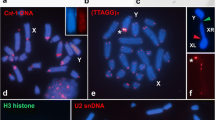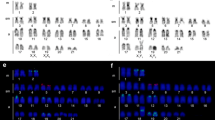Summary
-
I.
Blaps mucronata has a diploid number of thirty six chromosomes in the male; four of these are sex chromosomes. Second metaphase nuclei contain either seventeen or nineteen chromosomes indicating a segregation of three X chromosomes from a single Y at the first division.
-
II.
A distal euchromatic segment of the acrocentric Y pairs by chiasma formation with the terminal part of the euchromatic acrocentric XI. The other two X chromosomes are positively heterochromatic at first prophase and they associate with the proximal heterochromatic segment of the Y by means of a nucleolus.
-
III.
The metaphase orientation of the sex-multiple is invariably convergent:
-
1.
The centromeres of the X1 Y bivalent co-orientate as do those of normal bivalents.
-
2.
The centromeres of X2 and X3 on the one hand and that of the Y on the other lie on opposite sides of the equator because the Y chromosome repels the two X chromosomes more strongly than they repel one another.
-
3.
Convergent orientation, with the Y centrally placed, is prevented by the rigidity of the multiple.
-
1.
-
IV.
The evolution of the multiple sex chromosome systems in the genusBlaps has involved at least two factors:
-
1.
Polyploidy, possibly associated with hybridisation, and
-
2.
successive allosome/autosome translocations followed by reduction and loss of the Y and the “heterochromatinisation” of:
-
a)
the non-pairing X-chromosomes, and
-
b)
the differential segment of the Y.
-
a)
-
1.
Similar content being viewed by others
Literature cited
Baker, J. R.: Cytological technique. London: Methuen 1950.
Callan, H. G., andP. A. Jacobs: The meiotic process inMantis religiosa L. males. J. Genet.55, 200–217 (1957).
Cooper, K. W.: The mechanism of non-random segregation of sex chromosomes in maleDrosophila miranda. Genetics31, 181–194 (1946).
Darlington, C. D.: The external mechanics of the chromosomes. I.–IV. Proc. Roy. Soc. Lond. Ser. B121, 264–319 (1936).
—: The genetical and mechanical properties of the sex chromosomes. V.Cimex and theHeteroptera. J. Genet.39, 101–137 (1939a).
—: The evolution of genetic systems. Cambridge: University Press 1939b.
—: Nucleic acid and the chromosomes. Symposia Soc. Exper. Biol.1, 252–269 (1947).
—: Polyploidy in animals. Nature (Lond.)171, 191 (1953).
- Conference on chromosomes. Netherland 1956.
Darlington, C. D., andL. F. La Cour: The handling of chromosomes. London: Allen & Unwin 1942.
Guénin, H. A.: L’évolution de la formule chromosomique dans le genreBlaps (Coleopt. Ténébr.) Rev. Suisse Zool.56, 336 (1949).
—: Hétérochromosomes de Cicindèles. Rev. suisse Zool.59, 277–282 (1952).
—: Les chromosomes sexuels multiples duBlaps polychestra Forsk. (Col. Ténébr.) Rev. suisse Zool.60, 462–466 (1953).
King, R. L.: Neo-Y chromosome inHypochlora alba andMermiria intertexta (Orthoptera: Acrididae). J. of Morph.87, 227–257 (1950).
King, R. L., andH. W. Beams: The multiple chromosomes ofParatylotropidia brunneriScudder (Orthoptera: Acrididae). J. of Morph.63, 289 bis 300 (1938).
La Cour, L. F.: Heterochromatin and the organisation of nucleoli in plants. Heredity (Lond.)5, 37–50 (1951).
Lewis, K. R.: Squash techniques in the cytological investigation of mosses. Trans. Brit. Bryological Soc.3, 279–284 (1957).
Muller, H. J.: Some genetic aspects of sex. Amer. Naturalist66, 118–138 (1932).
Östergren, G.: The mechanism of co-orientation in bivalents and multivalents. The theory of orientation by pulling. Hereditas (Lund)37, 85–156 (1951).
Piza, S. de T.: Uma nova modalidade de sexodeterminação no grilo sud-americanaEneoptera surinamensis. An. Esc. Agricult. Queiroz3, 69–88 (1946).
Payne, F.: The chromosomes ofCryllotalpa borealisBurm. Arch. Zellforsch.9, 141–148 (1912).
—: A study of the germ cells ofGryllotalpa borealis andGryllotalpa vulgaris. J. of Morph.28, 287–327 (1916).
Revell, S. H.: Controlled X-segregation at meiosis inTegenaria. Heredity (Lond.)1, 337–347 (1947).
Sharman, G. B., andH. N. Barber: Multiple sex chromosomes in the marsupialPotorus. Heredity (Lond.)6, 345–355 (1952).
Smith, S. G.: The evolution of heterochromatin in the genusTribolium (Tenebrionidae, Coleoptera). Chromosoma4, 585–610 (1952a).
—: The cytology of some tenebrionid beetles (Coleoptera). J. of Morph.91, 325–363 (1952b).
—: Chromosome numbers ofColeoptera. Heredity (Lond.)7, 31–48 (1953).
Smith, S. G., andR. S. Edgar: The sex determining mechanism in some North AmericanCicindelidae (Coleoptera). Rev. suisse Zool.32, 657–667 (1954).
Sturtevant, A. H.: Preferential segregation in triplo-IV females ofDrosophila melanogaster. Genetics21, 444–446 (1936).
Suomalainen, E.: Die Chromosomenverhältnisse in der Spermatogenese einiger Blattarien. Ann. Acad. Sci. fenn., Ser. A4, Nr10, 1–60 (1946).
Upcott, M.: The origin and behaviour of chiasmata XII.Eremurus spectabilis. Cytologia7, 118–130 (1936).
—: The genetical structure ofTulipa. III. Meiosis in polyploids. J. Genet.37, 303–339 (1939).
White, M. J. D.: The origin and evolution of multiple sex chromosome mechanisms. J. Genet.40, 303–336 (1940).
Animal cytology and evolution. Cambridge: University Press 1954.
Author information
Authors and Affiliations
Rights and permissions
About this article
Cite this article
Lewis, K.R., John, B. The organisation and evolution of the sex multiple in Blaps mucronata. Chromosoma 9, 69–80 (1957). https://doi.org/10.1007/BF02568066
Received:
Issue Date:
DOI: https://doi.org/10.1007/BF02568066




